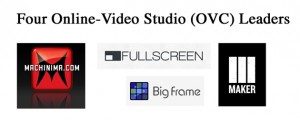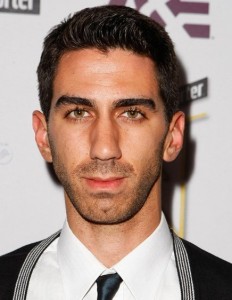Biggest Online-Video Studios: Machinima, Maker, Full Screen and BigFrame
Several years ago an independent YouTube creator wasn’t just an actor or actress – they actually wrote their own show, owned their own production studio, managed a mini-cable network and oversaw their content’s promotion and distribution. As the online-video leader, YouTube provided a platform to access an audience directly, and eventually helped creators earn money by sharing advertising revenue.
But as the online-video market continues to mature, it’s beginning to adopt industry attributes of early radio, television, cable and film. Small studios have emerged– let’s call them “Online Video Studios” (OVS). These formed in various ways to support creators and make money, and they each are grappling with their role in the emerging media landscape. Most remain small and independent, although at least two OVS companies been acquired: this week Discovery Communication bought Revision3 and a year ago Google bought Next New Networks.
Google itself is investing in “YouTube Originals” content (recently announcing an additional $200 million), but has avoided becoming an OVS. It is ceding content ownership to third parties – perhaps both to keep neutrality and avoid a Paramount-like antitrust case.

WHAT IS AN OVS?
Four of the OVS leaders (profiled briefly below) are Machinima, Maker, Full Screen and BigFrame. They have little in common beyond ranking high on ComScore’s list of most-viewed YouTube “channels” (this is misleading because an OVS is, in fact, a collection of separate independent and owned shows or channels).
But what is a traditional media analog to an OVS — is it a star coalition, creative studio, cable station, production company, distributor or promoter? Let’s look at some key points about film, television and cable:
- Growing movie studios in the early 1900 began to control creators and controversially achieved vertical integration by acquiring and constructing theatre chains.
- Star coalitions like United Artists, which included Charles Chaplin and Douglas Fairbanks, formed to offset the muscle of these creative studios (Hollywood producers and distributors).
- Modern film and television production companies include Pixar, Twentieth Century Fox or Paramount.
- Media conglomerates include Disney, Time Warner and Viacom.
- Cable television stations like HBO launched in 1972 as the first pay-TV network.
The OVC takes on some attributes of all, but each OVC varies in its identity. What’s most revealing is its origin, leadership and primary content (in profiles below you’ll see such emphasis as comedy, music and video gaming). Ultimately, of course, their function will be influenced by the roles YouTube and traditional media companies assert in online video. Unlike radio, television and film industries, YouTube’s audience dominance continues to provide Google with the most clout in this online-video marketplace.
Here’s how others are describing OVS leaders:
- “These are new-generation studios, folks that are growing up from the basement who are choosing to collaborate and form these networks,” Hunter Walk, head of product management at YouTube told Forbes. “In many ways they are like the first cable stations 30 years ago.”
- NYC Times writes, “studios are trying to play the same role for the online video service that United Artists did almost a century ago for movies or MTV did for television in the 1980s.”
- DECA (a company that owns Mondversations and launched Lonelygirl15) calls itself everything from a builder of “influence networks around celebrities and brands” to a “women’s digital media company that creates and syndicates premium video content.”
FUNCTION OF OVS
The OVC leaders have monthly views that exceed many network shows or cable channels (according to ComScore, which is US only). Profiled below are four of the largest: Machinima, Maker, Full Screen and Big Frame. To over simplify their role, here are some of the things they do:
- Help creators build and share audiences
- Provide access to common production and promotion services
- Liaison between individual creators and YouTube, since YouTube is unable to work directly with the rapid increase of top creators.
- Seek sponsors for branded entertainment opportunities
HOW DOES AN OVS MAKE MONEY?
These are small, private companies; so it’s hard to be sure if they make money, much less how. But here are some examples of revenue sources I’ve seen:
- Some claim a percentage of a creator’s ad revenue via YouTube. Established YouTube “stars” generally refuse such an arrangement, but “up and comers” are more willing.
- Other models allow the OVC to profit from the gap between what advertisers will pay per view, and the negotiated “cap” it pays creators. For instance, the OVC contractually locks the creator at a ceiling and floor of $1.50 cents per 1,000 views; then the OVC sells ads via YouTube maybe at $2 to $5 per 1,000 views. (I’ve avoided signing onto this model because I don’t like capping my income as online-video ad prices continue to soar).
- A few studios secure sponsorships via brands and agencies, then split the revenue with creators. For instance, the studio gets $200,000 from an agency’s media budget; then they pay each creators $5-$20,000 (depending on audience size) to create a video featuring the product. That was what Hitviews did before they closed shop earlier this year.
- Finally, traditional studios sometimes pay new studios retainers (or revenue splits) to help adapt and promote content via emerging online-video channels.
FOUR OVS LEADERS:
(cited stats are via a ComScore March 2012 data, which looks only at unique US video viewers… obviously total views far exceeds these numbers, especially when we include global data).

1) Machinima
22.8 MM viewers
Machinima originated as a gaming and media streaming website, then migrated content to YouTube creating some of the most popular channels on such gaming topics as Skyrim, Mortal Combat, Sonic and Minecraft. The Los Angles-based company has begun to sign other non-gaming YouTube channels, and helped launch the YouTube Original, “Dance On.”
Leadership: Allen DeBevoise, chief executive of Machinima, who has 30 years of experience in the multimedia and Internet arenas focusing on early stage companies and technologies.

2) Maker Studios Inc
14.6 MM viewers
The Maker studio emerged out of The Station, a cooperative channel of top YouTube “stars” like Lisa Donovan (LisaNova), Shay Butler (ShayCarl/ShayTards), Kassem Gharaibeh (KassemG), and Peter Alexis Shukoff (NicePeter). New Channels include: Maker Music Network, The Mom’s View Network and Tutele, a bicultural channel. The studio has $1.5 million in funding in a round led by Greycroft Partners (Ad.ly, Klout and Vuze), and GRP partners, and follow-on rounds according to Maker’s Will Keenan. 5/5 addition: Keenan says Maker does not have an income cap as described in the various revenue models.
Leadership: Dan Zappin, Lisa Donovan and Ben Donovan.
3) FullScreen

11.9 MM viewers
FullScreen has 400 channels, and connects YouTube stars, advertisers and offline distributors as a “one-stop shop for original content” (AdAge). It lists such clients as Mattel, Nintendo, General Electric and P&G.
Leadership: FullScreen was founded by George Strompolos, a former Google executive who was active in creating YouTube’s Partner program. FullScreen’s COO is Ezra Cooperstein who helped found Maker Studios and was a VP at CurrentTV)

4) Bigframe
8 MM viewers
Bigrame was formerly known as The Cloud Media, and was the group behind The Digitour. The music-oriented studio includes some of YouTube’s most-viewed personalities like Joe Penna (Mystery Guitar Man), Tim Destorm, and DaveDays. New content includes Bammo, which “features YouTube’s special effects masters.” The OVC lists clients as Levi’s, Home Depot and Sony. See this article on Gigaom for more.
Leadership: CEO Steve Raymond was a VP at Comcast Digital Entertainment and has been a leader at several digital-media startups. Sara Evershed Penna founded Bigframe, and manages talent management. She is married to Joe Penna, and worked on reality TV shows before moving online.
Editor’s Note: I researched about 35 sources for this information, and tried to credit appropriately.
If I have any facts wrong, please comment below and I’ll fix.

Biggest Online-Video Studios: Machinima, Maker, Full Screen and BigFrame http://t.co/38qlNwAK
Leading “online-video studios” explained. http://t.co/Y5Wxmepi @Machinima_com, @MakerStudios, @fullscreen, @bigframeco @comscore
Excellent survey by @nalts of the biggest online video studios (part of how YouTube is evolving, getting more pro) http://t.co/CgFzNROb
RT @nalts: Leading “online-video studios” explained. http://t.co/Y5Wxmepi @Machinima_com, @MakerStudios, @fullscreen, @bigframeco @comscore
I’m impressed that you did some research.
My neck hurted I spent so long on this post.
And no network will ever produce the gold that Nalts created. Long live Nalts.
BuddhaCharlie
Biggest Online-Video Studios: Machinima, Maker, Full Screen and BigFrame: Several years ago an independent YouTu… http://t.co/RDiD6lqx
Very interesting!
Interesting. Helps to have it spelled out like this. So how do we start our own?
http://t.co/ku8Q6fGQ Biggest Online-Video Studios: Machinima, Maker, Full Screen and …
Oh sweet- you can comment using your twitter or facebook I think.
Reading @nalts article on the ‘big four’ http://t.co/FYBvputj cc: @machinima_com @Jeremy_Azevedo
Lotta words here. Too bad you don’t get paid for this shit.
Nice article, Nalts. Good job breaking down the studios and what they do. I think it’s good for people who decide to take this route to know what they’re getting into and signing up for.
Thanks. I probably should do a blog post on “pros/cons” of joining the network. Pros- are potential access to advanced youtube features, and maybe cross marketing. Cons- income ceiling.
And I am proud to be a member!
A member of what?
RT @nalts: Leading “online-video studios” explained. http://t.co/Y5Wxmepi @Machinima_com, @MakerStudios, @fullscreen, @bigframeco @comscore
Great review of online video market’s current state by @nalts. Online video studios are TNG of our media networks. http://t.co/c2ofcxNE
Maker Studios did not come from The Station. Maker Studios was formed first and The Station was their “flagship channel”. source: Podcast #38 WTKGTS with Shay Carl and Sarah Penna